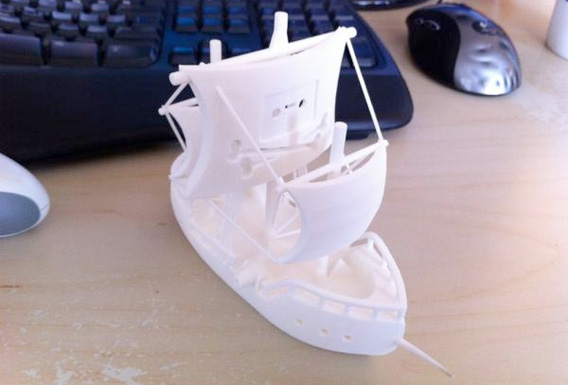The DIY Copyright Revolution
How 3-D printing will change the way we think about intellectual property.

Photo courtesy Charles Randall.
This article arises from Future Tense, a collaboration among Arizona State University, the New America Foundation, and Slate. On Feb. 29, Future Tense will host an event on the Make movement and do-it-yourself innovation in Washington, D.C. For more information and to sign up for the event, please visit the NAF website.)
It is something of a fluke that copyright law has become so intertwined with our online lives. For most people, the first things that were easy to create and distribute online—articles, pictures, music, movies—also happened to be material protected by copyright. This trained us to assume that we need permission to do just about anything in the digital space—and, increasingly, in the real world.
Fortunately, a technology on the verge of going mainstream will soon give us a chance to re-examine the role that copyright plays in our lives. By connecting the physical and the digital, 3-D printers remind us that copyright is not a general-purpose legal right that allows people to demand control over whatever they want. Instead, copyright has a narrow scope. And most of the things that make up our world simply do not fall into it.
3-D printing takes digital design files and transforms them into real objects. The methods and materials vary, but all 3-D printers essentially work by building up an object one tiny layer at a time. Industrial 3-D printers have been around for a while and are used to build custom jaw replacements, airplane components, and product prototypes. Personal 3-D printers are just starting to come to the market and can create jewelry, bike hardware, and, well, most of the parts to build another personal 3-D printer.
In the universe of movies, music, books, and articles, the assumption is that you need permission to make use of just about everything (or that you have a reason not to need permission, such as fair use). After all, the difference between downloading a song legally and downloading it illegally largely comes down to whether the person who controls its rights gave you permission to do so.
In the physical world, the assumption is just the opposite. In the majority of cases, you do not need anyone’s permission to copy, improve, or build upon an existing object. Broadly speaking, copyright does not apply to so-called “useful objects”—objects that do something besides look nice. Giant sculptures in the middle of Washington, D.C.? Protected by copyright. That broken hinge on your old record player? Not protected by copyright.
Useful objects can be protected by patent. But patents are harder and more expensive to get than copyrights and last a much shorter amount of time. Without doing anything else, as soon as I write something down (like, say, this article), it is protected by copyright for my entire lifetime plus 70 years after I die. In contrast, in order to get a patent on a new useful object, I would need to pay to apply for a patent, prove that my invention is actually new, and wait to get approved. Even if I got approved, the patent only lasts for 20 years. Trademarks lie somewhere in the middle. They can protect non-useful objects but, like patents, trademarks need to be applied for and are not automatic.
As a result, most objects in the physical world are not protected by an intellectual property right, either because they never were or because that protection expired long ago. Any attempt to draw a parallel between 3-D printing and the early days of online music or movie file sharing must come to terms with that critical distinction. Simply because a website like the Pirate Bay decides to open up a “Physibles” section does not make copying a physical object an act of “piracy.”
After all, the lack of automatic intellectual property rights for all physical objects is not some sort of loophole or blind spot in the law. Copyrights and patents give creators a temporary monopoly in order to motivate them to create. Even though most physical objects have neither copyright nor patent protection, people continue to create, and profit from creating, physical objects. This is true even though we have been copying and improving other people's physical objects just as long as we have been building them.
At a time when copyright discussions have expanded to the point where universities and students are locked in a fight over who owns the copyright to notes taken in class, 3-D printers serve as a reminder that not everything is swaddled in rights. You do not always need permission to build upon the past. The fact that someone could try to charge you to do something does not mean that they have a legal right to do so.
Fifteen years ago, this would not have surprised anyone. While copyright was important in some industries, it was something that most people did not need to be aware of in their everyday lives. Among its many unexpected side effects, the Internet has forced copyright into our collective consciousness and trained us to believe that there is always a gatekeeper with the ability to grant—or refuse—permission to copy, build on, or use just about anything.
It is impossible to predict all of the ways that widespread access to 3-D printing could change our society. However, before it revolutionizes manufacturing, design, or anything else, 3-D printing may first help us regain a much-needed perspective on the role intellectual property should have in the world.